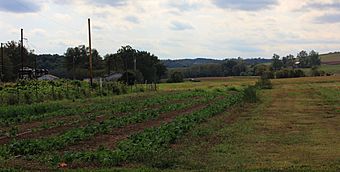Kentland Farm Historic and Archeological District facts for kids
|
Kentland Farm Historic and Archeological District
|
|

Kentland Farm, September 2012
|
|
| Location | At end of VA 623 along New River, near Blacksburg, Virginia |
|---|---|
| Area | 350 acres (140 ha) |
| Built | 1745, 1834-1835 |
| Built by | Swope, John |
| Architectural style | Greek Revival, Federal |
| MPS | Montgomery County MPS |
| NRHP reference No. | 91000833, 06000801 |
Quick facts for kids Significant dates |
|
| Added to NRHP | July 3, 1991, September 6, 2006 (Boundary Increase) |
Kentland Farm Historic and Archeological District is a special place near Blacksburg, Virginia. It's not just an old farm; it's also an important archaeological site where people have found clues about the past. This area includes a historic home built in the 1830s, along with many old farm buildings. It's also home to ancient Native American village sites, making it a truly unique historical spot.
Contents
Ancient Native American Life at Kentland Farm
Long ago, Native Americans lived on the land that is now Kentland Farm. Archeologists have found many signs of their presence.
Discovering Ancient Villages
In 1991, experts explored the farm and found evidence of a large Native American village. This village was from the Late Woodland Period, which was between 800 and 1600 AD. They found hundreds of artifacts, which are objects made by people in the past.
These artifacts included:
- Weapons and stone tools
- Pieces of clay pottery
- Rocks that were cracked by fire, likely from cooking hearths
There is also evidence that the Shawnee people lived in or traveled through this area in the late 1700s. They used the land around Kentland Farm, Toms Creek, Virginia, and the New River.
The Kent Family and Their Farm
In the early 1800s, James Randal Kent bought the farm. His family owned it for many years.
Life on the Farm Before the Civil War
Before the American Civil War, James Kent's farm was very successful. He grew many crops like corn, wheat, and oats. He also raised animals such as horses, cattle, sheep, and pigs.
James Kent was one of the wealthiest landowners in Montgomery County, Virginia. He owned a large number of enslaved people who were forced to work on his farm. By 1860, James and his daughter, who owned another farm nearby, together enslaved about 250 people.
Historic Farm Buildings
Today, you can still see several buildings from the Kent family's time. These include the main brick house, which was built before the Civil War. There are also other old farm buildings, a mill, and garden areas. The farm has cemeteries for both the Kent family and the enslaved community.
The main house was built in 1834-1835. It was made of brick to help keep it cool in the summer heat. German stonemasons helped by mining limestone from a nearby mountain. Enslaved people mined clay and made the bricks for the house and a special six-sided smokehouse. Inside the house, there's a beautifully carved wooden handrail on the main staircase.
While some buildings are very old, others were built more recently. Some old barns have even held surprising finds, like an old apple cider press and early chain saws. These have been fixed up and are now used by students.
Kentland Farm and Virginia Tech
Virginia Tech bought Kentland Farm in 1986. They acquired the farm, along with over 3,200 acres of land.
Research and Education at the Farm
Virginia Tech uses Kentland Farm to support its teaching, research, and outreach programs. These programs are mainly for the Virginia Tech College of Agriculture and Life Sciences.
There have been discussions about preserving the history of African Americans who lived and worked on the farm. This includes finding and protecting slave cemeteries, cabins, and other evidence of their lives there.
Virginia Tech's famous "Hokie milk" comes from cows raised by the university. The school's large dairy herd and production facility have moved to Kentland Farm. A new dairy center was built there to house the cows and produce the milk.
Other projects at the farm include improving the soil quality for farming.
National Recognition
Kentland Farm Historic and Archeological District was added to the National Register of Historic Places in 1991. This means it's recognized as an important historical site in the United States. Its boundaries were expanded in 2006 to include more of the historic area.



